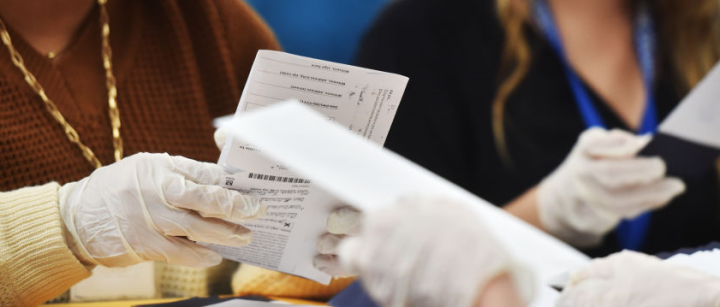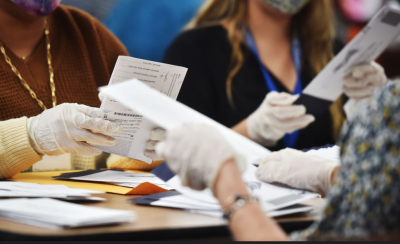
Este artículo estará disponible en español en El Tiempo Latino.
Former President Donald Trump cited the dubious results of a poll commissioned by a conservative group as the foundation for his latest claim of rampant voter fraud among mail-in voters.
“An interview by Tucker Carlson of an election expert indicates that 20% of the Mail-In Ballots in Pennsylvania are fraudulent. Here we go again!” Trump posted on Truth Social on Sept. 8.
Here we go again, indeed. Trump has repeatedly made false claims about voter fraud, continuing to say the 2020 election was “rigged,” despite the fact that his own aides, including his attorney general, told him his claims were baseless.
We did not get a response from the Trump campaign when we asked for backup, but it appears he was referring to an interview Carlson, a former Fox News host, did in April with Justin Haskins of the conservative Heartland Institute. Haskins’ title there is “director of the Socialism Research Center,” and his bio on the Heartland website describes him as a “widely published writer and political commentator.” In other words, not an “election expert,” as Trump described him.
Here’s the relevant part of Carlson’s interview with Haskins:
Carlson, April 26: Was there voter fraud? Well, we know there was some, but was it widespread? That is a hard allegation to prove, though, of course, many people believe there was widespread fraud. Well, now it turns out we know for a fact that there was, and in fact, it can be proven with a poll. Just ask people, “Did you personally commit voter fraud?” Well, that has just been done. The answer is, a huge percentage of people asked in the poll admitted, “Yes. I committed voter fraud.” It’s remarkable. …
Haskins: So it was pretty straightforward. We asked people a series of questions. … One of the first questions was, “Did you vote in the 2020 election, and did you vote with an absentee ballot?” And if they answered yes to both of those questions, then we asked a bunch of questions related to voter fraud. We didn’t tell them … that we were asking, “Did you commit voter fraud?” We just asked them about various behaviors.
So, for example, we asked people, “Did you vote in a state where you’re no longer a legal resident?” That’s a pretty straightforward question. If you’re not a permanent resident of a state you can’t vote there. Seventeen percent of people, nearly 1 in 5, said yes, they did do that. We asked people, “Did you fill out a ballot for someone else on their behalf?” That’s also illegal. You’re not allowed to fill out someone else’s ballot. Twenty-one percent of people said yes to that question. We asked if people forged the signature of a friend or family member on their behalf, with or without their permission — we actually put that in the poll question — and 17% of people said yes to that. So all told it’s at least, and I say at least, 1 in 5 mail-in ballots involved some kind of fraudulent activity.
In a post subsequent to the poll, the Heartland Institute argued, based on the “recently unearthed evidence indicating widespread mail-in voter fraud” indicated by the poll, that voter fraud swung the 2020 election from Trump to President Joe Biden.
For starters, the Nov. 30 to Dec. 6 poll commissioned by Heartland and conducted by Rasmussen Reports did not prove “for a fact,” as Carlson put it, that there was widespread voter fraud in the 2020 election. Nor is it “evidence” of fraud, as the Heartland Institute put it. It was a survey administered more than three years after the election.
Haskins described the questions put to mail-in voters as “straightforward,” saying that “yes” answers were indicative of illegal behavior. But take the question, “During the 2020 election, did you cast a mail-in ballot in a state where you were no longer a permanent resident?” Seventeen percent said “yes.” A careful reading of the question would suggest those who responded yes admitted to voting in the wrong state. But how many of those people mistakenly answered yes because they had moved to a different state since the election, or mailed their ballot from a state that was not their permanent residence?
Another question asked, “During the 2020 election, did a friend or family member fill out your ballot, in part or in full, on your behalf?” (19% said yes) and another asked whether respondents had helped a friend or family member fill out a mail-in ballot (21% said yes). Haskins said that kind of behavior is illegal. But that’s not always true.
“We have seen an increase in attempts to frame assisting a person with a disability to vote as some sort of nefarious activity,” Michelle Bishop, manager for voter access and engagement for the National Disability Rights Network, told us via email. “It is indeed perfectly legal in every state to help a disabled person to fill out a mail-in ballot. It’s actually protected by federal law.”
According to Section 208 of the Voting Rights Act, “Any voter who requires assistance to vote by reason of blindness, disability, or inability to read or write may be given assistance by a person of the voter’s choice, other than the voter’s employer or agent of that employer or officer or agent of the voter’s union.”
The U.S. Department of Justice provides further guidance: “Voters with disabilities may receive assistance in all aspects of the voting process, including in requesting, completing, and returning a ballot, whether in person, absentee, or by mail-in ballot. For example, if a voter with a disability requires assistance to mark a ballot, the voter must be allowed to receive assistance from the person of their choosing and is not limited to assistance from an election worker.” That includes “qualified voters with a disability who reside in congregate settings such as nursing homes.”
But experts told us there are other reasons to be skeptical of the poll’s findings. The Rasmussen Reports poll was a national survey of 1,085 “likely voters.” Pennsylvania is shaping up as one of the most important swing states of the 2024 election, which is likely why Trump singled out alleged voter fraud there. But a polling expert told us that “nothing can be said about Pennsylvania” from the Heartland poll because it was a national poll.
 Pennsylvania mail-in ballots being counted by Luzerne County employees during the 2020 election. Photo by Aimee Dilger/SOPA Images/LightRocket via Getty Images.
Pennsylvania mail-in ballots being counted by Luzerne County employees during the 2020 election. Photo by Aimee Dilger/SOPA Images/LightRocket via Getty Images.According to Jon Krosnick, director of the Political Psychology Research Group at Stanford University, Rasmussen “is known to produce very biased results, typically pro-Republican.”
Rasmussen Reports did not respond to our queries, but an FAQ page on its website states, “Rasmussen Reports is an independent polling firm with a bi-partisan staff. We do not endorse any political philosophies, parties or special interest groups.”
According to its methodology page, Rasmussen Reports’ “survey questions are digitally recorded” and “[c]alls are placed to randomly selected” landline telephone numbers. It supplements those responses with surveys from an online panel maintained by Rasmussen.
In 2023, ABC News sent a letter to Rasmussen Reports warning that the news organization’s polling site FiveThirtyEight was “considering formally banning Rasmussen Reports from its coverage.” The ABC News letter asked Rasmussen Reports to “explain the nature of its relationship with several right-leaning blogs and online media outlets, which have given us reason to doubt the ethical operation of the polling firm” and asked numerous questions about its methodology. In March, the Washington Post reported that FiveThirtyEight “dropped the right-wing polling firm Rasmussen Reports from inclusion in its polling averages and forecasts.”
Part of the problem with Rasmussen Reports’ polls, Krosnick told us, is that it uses a digitally recorded voice to survey homes with landlines, and only about a quarter of Americans still have landlines. It is illegal to call cell phones with automated messages, Krosnick said, and so “people potentially reached by Rasmussen’s automated calls is not quite one quarter of American adults.”
Rasmussen Reports notes that, “[l]ike many other pollsters, we now also draw a sizable percentage of our daily sample survey results from special demographically balanced Internet Panels to capture the growing number of people who no longer have landline telephones.”
But Krosnick, a winner of the American Association for Public Opinion Research’s Lifetime Achievement Award for outstanding research, warns not to put much stock in that.
“[T]he vast majority of Rasmussen data come from an ordinary opt-in online panel” in which participants actively seek to join rather than being randomly selected, “which AAPOR tells you cannot have a margin of error, because there is no systematic sampling involved,” Krosnick said. “The Rasmussen claim about ‘randomly selected’ means random selection from among a non-random subset of the American population. That doesn’t make the result a random sample of the national population.”
The poll purports to have a “Margin of Sampling Error, +/- 3 percentage points with a 95% level of confidence,” but only 30% of those surveyed responded that they voted in 2020 via absentee or mail-in ballot. So those who said they voted by mail-in ballots represent a subset of the larger polling group. (The Election Assistance Commission reported that about 43% of the electorate voted by mail in 2020. A Pew Research Center survey found that 65% of mail or absentee voters voted for Biden, while only 33% voted for Trump.)
“[P]roperly computed margins of error get bigger as sample size gets smaller,” Krosnick said. “So the margin of error on just a subset of respondents will be larger than for the full sample. But Rasmussen’s figure for the full sample is based on assumptions that are absolutely not met.”
Justin Levitt, a law professor at Loyola Marymount University and an election law expert who served from 2021 to 2022 as the White House’s first senior policy advisor for democracy and voting rights, further noted that “the poll seems to have found an intriguing amount of parity – just about half of the responses purportedly indicating fraud were Republicans.”
(Heartland argues that the alleged fraud benefited Democrats more than Republicans because a larger percentage of Democrats voted by mail-in ballot.)
Moreover, Levitt said, “the responses are sufficiently out of line with everything else we know that I find them very hard to trust at all.”
“[T]he results are wildly out of line with literally all other incoming information, including the rate of ballots flagged in any jurisdiction anywhere in the country for signature mismatches,” Levitt told us via email. “It’s the equivalent of a national poll that has Trump – or Harris – up by 50%. Or a finding that the murder rate in a given area was 1 out of 3 adults. If you got results like that, you’d be plenty skeptical of the information, even without an obvious problem in the collection.”
In an analysis of the Rasmussen poll when Trump touted it last December, the Washington Post’s Philip Bump wrote that the findings of the poll fail “the smell test.”
“A fifth of voters said they voted in a state where they no longer live? About 6 in 10 Americans have never moved out of the states in which they were born,” Bump wrote. “Half of the rest, we are meant to believe, committed an obvious form of election fraud three years ago.”
Bump further mocked the finding that 8% of all voters answered “yes” to the question, “During the 2020 election, did a friend, family member, or organization, such as a political party, offer to pay or reward you for voting?”
“[P]rofessional and amateur sleuths have also somehow not found evidence showing that 1 in 12 absentee voters — millions of people! — were offered cash for their votes,” Bump noted. “This would seem like it might leave a trail.”
We reached out to the Pennsylvania Department of State, which oversees the state’s elections, about Trump’s claim that 20% of mail-in ballots may be fraudulent.
“Voting by mail is safe and secure, and no evidence exists of widespread mail voting fraud in Pennsylvania,” the department told us in an emailed statement.
“Mail ballot fraud has been proven to be exceptionally rare,” the statement continued. “Claims of systemic voter fraud are devoid of any supporting evidence and have consistently been rejected by judges, government agencies, and election experts across the political spectrum.”
An Associated Press review of potential voter fraud cases in six swing states found fewer than 475 instances of potential fraud – “a number that would have made no difference in the 2020 presidential election.” Election expert Richard Hasen, a law professor at UCLA, wrote in a 2020 op-ed in the Washington Post: “While certain pockets of the country have seen their share of absentee-ballot scandals, problems are extremely rare in the five states that rely primarily on vote-by-mail, including the heavily Republican state of Utah.”
A signature is required to vote in Pennsylvania, but the commonwealth does not require election officials to verify signatures. In fact, facing lawsuits, state officials in 2020 told county officials they could not reject a ballot solely on the belief that a signature on the ballot doesn’t match the voter’s signature on file.
However, the DOS statement said, “Mail voting in Pennsylvania has multiple layers of security that involve registered voters having to provide appropriate ID before their mail ballot can be counted and that prevent any voter from casting more than one ballot in any given election. Pennsylvanians have been voting by mail since the Civil War, and the process has a long history of being safe and secure.”
Editor’s note: FactCheck.org does not accept advertising. We rely on grants and individual donations from people like you. Please consider a donation. Credit card donations may be made through our “Donate” page. If you prefer to give by check, send to: FactCheck.org, Annenberg Public Policy Center, 202 S. 36th St., Philadelphia, PA 19104.
The post Trump’s Latest Bogus Claim About Mail-In Vote Fraud in Pennsylvania appeared first on FactCheck.org.

 3 months ago
42
3 months ago
42


